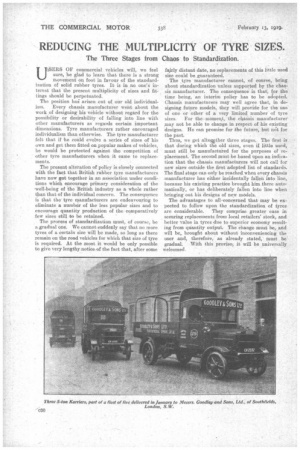REDUCING THE MULTIPLICITY OF TYRE SIZES.
Page 10

If you've noticed an error in this article please click here to report it so we can fix it.
The Three Stages from Chaos to Standardization.
UABM. OF commercial vehicles will, we feel sure, be glad to learn that there is a strong movement on foot in favour of the standardization of solid rubber tyres. It is in no one' S interest that the present multiplicity of sizes and fittings should be perpetuated.
The position has arisen out of our old individualism. Every chassis manufacturer went about the work of designing his vehicle without regard for the possibility or desirability of falling into line with other manufacturers as regards certain important dimensions. Tyre manufacturers rather encouraged individualism than otherwise. The tyre manufacturer felt that. if he could evolve a series of sizes of his awn and get them fitted on popular makes of vehicles, he would be protected against the competition of other tyre manufacturers when it came to replacements.
The present alteration of policy is closely connected with the face that British rubber tyre manufacturers have now got together in an association under conditions whick encourage primary consideration of the well-being of the British industry as a whole rather than that of the individual concern. The consequence is that the tyre manufacturers are endeavouring to eliminate a number of the less popular sizes and to encourage quantity production of the. comparatively -few sizes still to be retained.
The process of standardization must, of course, be a gradual one. We cannot suddenly say that no more tyres of a certain size will be made, so long as there remain on the road vehicles for which that size of tyre is required. At the most it would be only possible to give very lengthynotice.of the fact that, after some fairly distant date, no replacements of this little used size could be guaranteed. • The tyre manufacturer cannot, of course, bring about standardization unless supported by the chassis manufacturer. The consequence is that, for the time being, an interim policy has to be adopted. Chassis manufacturers may well agree that, in designing future models, they will provide for the use of one or other of a, very limited number of tyre sizes. For the moment, the chassis manufacturer may not be able to change in respect of his existing designs. He can promise for the future, but na far the past.
Thus, we get altoggther three stages. The first is that during which the old sizes, even if little used, must gill be manufactured for the purposes of replacement. The second must be based upon an indication that the chassis manufacturers will not call for new sizes outside the first adopted list of standards. The final stage can only be reached when every chassis manufacturer has either incidentally fallen into line, because his existing practice brought him there automatically, or has deliberately fallen into line when bringing out his designs of new models.
The advantages to alI.concerned that may be expected to follow upon the standardization of tyres are considerable. They comprise greater ease in securing replacements from local retailers' stock, and better value in tyres due to superior economy resulting from quantity output. The change must be, and will be, brought about without inconveniencing the user and, therefore, as already stated, must be gradual. With this proviso, it will be universally welcomes].






















